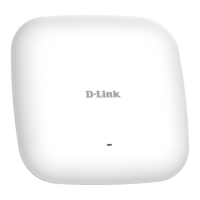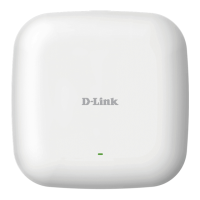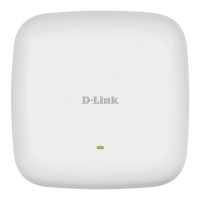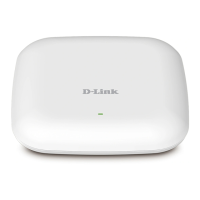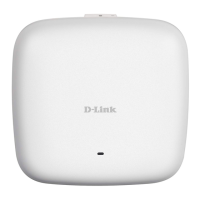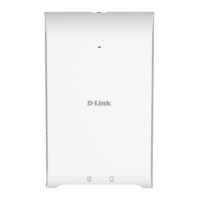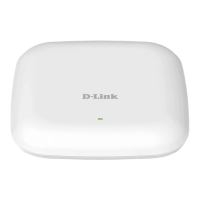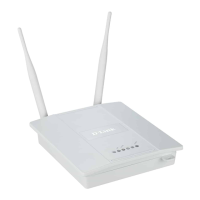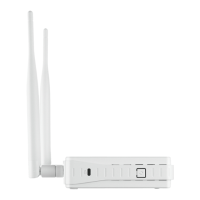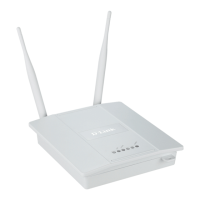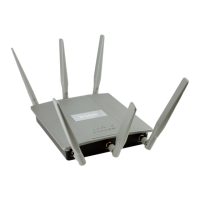




Do you have a question about the D-Link DAP-2695 and is the answer not in the manual?
| operating temperature | 0˚C to 40˚C |
|---|---|
| storage temperature | -20˚C to 65˚C |
| operating humidity | 10%~90% (non-condensing) |
| storage humidity | 5%~95% (non-condensing) |
| operating voltage | 48V DC +/- 10% for PoE |
|---|---|
| voltage and current for PoE | 48V/0.5A |
| wireless frequency range | 2.4 to 2.4835 GHz and 5.15 to 5.85 GHz |
|---|---|
| antenna type at 2.4GHz | 3x Detachable 4 dBi Omni antennas |
| antenna type at 5GHz | 3x Detachable 6 dBi Omni antennas |
| length | 198.8 mm |
|---|---|
| width | 190 mm |
| height | 36.5 mm |
Explains the DAP-2695's wireless security features, including WPA/WPA2, RADIUS, MAC filtering, and VLANs.
Guides the user on configuring wireless settings, including modes like Access Point, WDS with AP, WDS, and Wireless Client.
Details the configuration steps for setting up the DAP-2695 in Access Point mode, including SSID, visibility, and channel settings.
Explains how to configure the DAP-2695 for WDS with AP mode, covering remote AP MAC addresses and site survey.
Describes the configuration for WDS mode, including remote AP MAC address and site survey functionalities.
Details wireless encryption methods like WEP, covering Open System and Shared Key configurations.
Explains WPA and WPA2 security, including WPA-Personal and WPA-Enterprise modes, cipher types, and passphrases.
Guides on setting up multiple SSIDs, including enabling support, band, index, visibility, and security.
Covers VLAN support, including creating VLANs with names and VIDs, and assigning them to ports.
Details how to add or modify VLANs, including assigning ports and configuring VLAN IDs and names.
Details the setup of the built-in RADIUS server, including adding user accounts and managing their status.
Explains how to enable ARP spoofing prevention and add IP/MAC address mappings to prevent attacks.
Allows users to manage bandwidth, set downlink/uplink limits, and allocate bandwidth per station or SSID.
Covers AP Array setup for managing up to 32 APs as a single group, including scanning and connection status.
Details Captive Portal setup for web authentication, focusing on Web Redirection Only.
Guides on configuring username/password authentication for captive portals, including session timeout and URL path.
Explains passcode authentication for captive portals, including passcode quantity, duration, and user limit.
Covers remote RADIUS authentication for captive portals, including server IP, port, and secret settings.
Details LDAP authentication for captive portals, including server, port, authentication mode, and base DN.
Explains POP3 authentication for captive portals, including server, port, and connection type settings.
Covers IP filter settings, allowing users to define IP addresses or network addresses for filtering.
Details wireless MAC bypass settings, allowing users to add MAC addresses to a bypass list or upload a bypass file.
Explains DHCP server functionality, including dynamic pool settings, IP assignment, subnet mask, and gateway.
Guides on assigning static IP addresses to specific wireless stations, including host name, MAC address, and IP address.
Covers Wireless MAC ACL settings for access control, allowing acceptance or rejection of devices based on MAC addresses.
Allows customization of downlink and uplink interfaces, specifying bandwidth rates for QoS and Traffic Manager.
Explains Quality of Service settings for prioritizing traffic, with four priority levels for applications.
Guides on creating traffic management rules, specifying how to handle client traffic and set speeds.
Details the process of uploading firmware and SSL certificates to upgrade the access point's software.
Allows backing up and restoring the access point's configuration files.
Provides solutions for issues accessing the web-based configuration interface, including browser and firewall checks.
Explains how to reset the access point to factory defaults if the password is forgotten.

